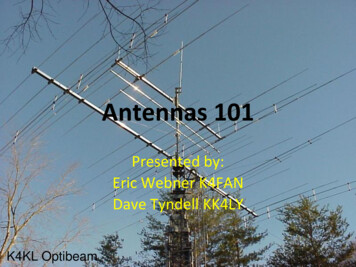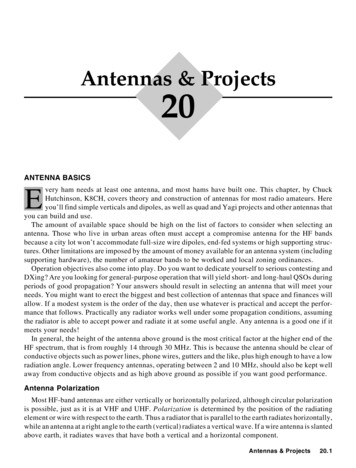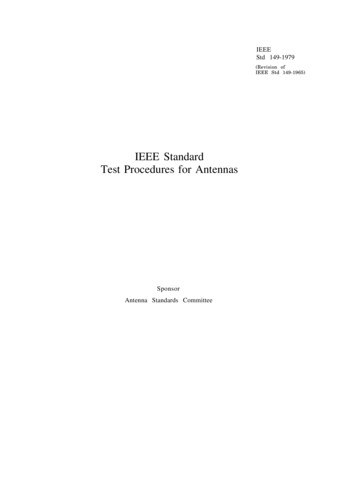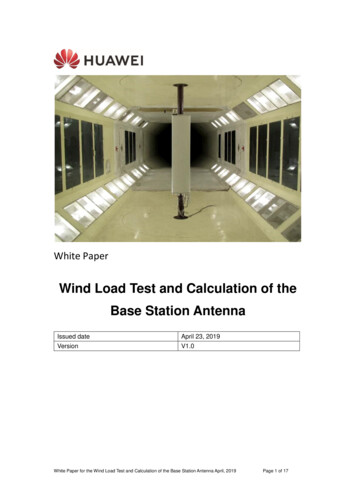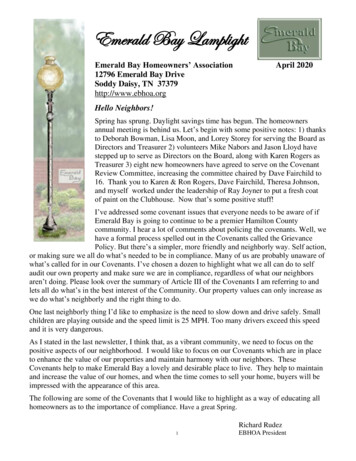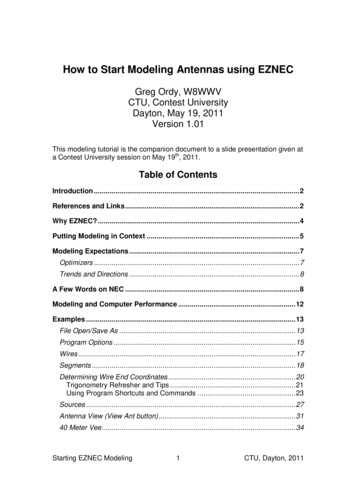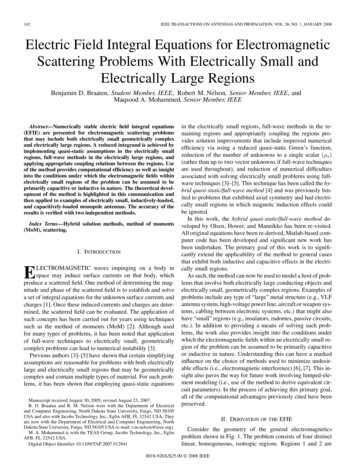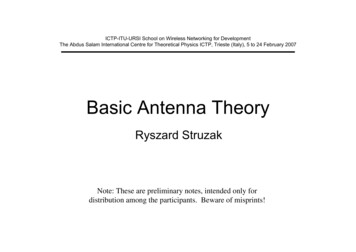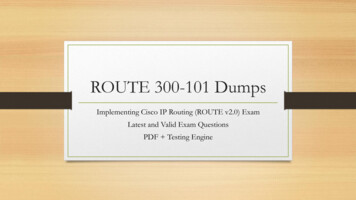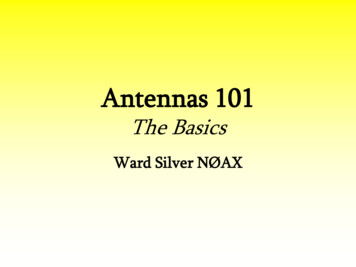
Transcription
Antennas 101The BasicsWard Silver NØAX
The Basics - 1 Antennas radiate (or receive) becauseelectrons are accelerated (or are caused toaccelerate) in the antenna’s elements Radio or electromagnetic waves are bothan E- (electric) and H- (magnetic) field Electrons move parallel to E-fields Strongest radiation from acceleratingelectrons linearly (back and forth)2013Antennas 1012
The Basics - 2 The orientation of the E-field determinesthe polarization of the wave because that’swhat makes the electrons move (current) Antennas transmit & receive radio wavesin the same way The radiation pattern shows howantennas distribute energy in space2013Antennas 1013
The Basics - 3 deciBels (dB) 10 log (power ratio) Impedance ratio of Voltage to Current Feed point - place where power is applied2013Antennas 1014
The Basics - 4-1 dB from themaximum gainreference valueAzimuthal Pattern2013Antennas 1015
The Basics - 5Elevation Pattern2013Antennas 1016
The Basics - 6 Front-to-Back, Front-to-Side, and Frontto-Rear ratios– Front-to-Rear ratio based on an averageacross 90 or 180 degrees “behind” the antennain the pattern’s rear quadrant(s)2013Antennas 1017
The Basics - 6RearFrontBackSide2013Antennas 1018
The Basics - 6 Beamwidth - angular width of main lobe– Angle between the two points at whichpower is ½ that at the peak (-3 dB points)2013Antennas 1019
The Basics - 6- 3 dBBeamwidth 68 2013Antennas 10110
The Basics - 7 Gain measures re-distribution of energy Gain is a comparison of antennas Gain is always with respect to a reference––––2013dBi (isotropic), dBd (free-space /2 dipole) /2 dipole has 2.15 dBi gainGround-plane gain equivalent to /2 dipole3-element Yagi may have up to 5 dBd gainAntennas 10111
QUESTIONS?2013Antennas 10112
The Dipole - 1 Oldest and simplest form of antenna– “Di” (two) “Pole” (voltage polarity)– Usually 1/2-wavelength long Similar to a vibrating string’s fundamental– Current maximum in the middle– Voltage maximum at the ends Pattern repeats every 1/2-wavelength– Direction or amplitude is reversed2013Antennas 10113
The Dipole - 2Current maximum (I)feed pointVoltage minimum (V)1/2 wavelengthIMPORTANT!!!A /22013B /2Antennas 101VIC /214
The Dipole - 3 Free-space wavelength ( )– c / f or 300 / f in MHz (in meters)– /2 492 / f in MHz (in feet) Length-to-diameter effect– Makes the antenna a little longer electrically– Thicker conductors are longer electrically Effect of height on electrical length– 460/f to 490/f (rarely 468/f)2013Antennas 10115
The Dipole - 4 Radiated energy is strongest perpendicularto an electron’s motion– electrons move along the length of a dipole– radiation strongest broadside to the dipole2013Antennas 10116
The Dipole - 4Directions ofMaximumRadiationDirections ofMinimumRadiationDipole AxisRadiation Pattern2013Antennas 10117
The Dipole - 5 Feed point impedance varies with position– High at the ends and low in the middle– Resonance – feed point impedance allresistive, no reactance Z R j 0 ohms Doesn’t matter what R is (any value, not just 50 Ω)2013Antennas 10118
The Dipole - 5Current Maximum (I)feed pointVoltage Minimum (V)1/2 wavelengthHigh ZLow ZHA /22013LB /2Antennas 101HVLIHC /219
The Dipole - 6 Inverted-Vee is a “bent” dipole Radiation pattern adds the effect ofground gain from reflections– Can add as much as 6 dB over free space– Free-space gain best comparative measure Ground gain varies with height and withground conductivity2013Antennas 10120
The Dipole - 635 /2groundInverted-VeeRadiation Pattern2013 /2Antennas 10121
QUESTIONS?2013Antennas 10122
The Ground Plane - 1 Start with a vertical dipole in free-space Cut off one half of the dipole Replace the missing half with a groundplane or counterpoise Omnidirectional if oriented vertically Also called a monopole2013Antennas 10123
The Ground Plane - 22013Antennas 10124
The Ground Plane - 32013Antennas 10125
The Ground Plane - 4 Equal radiationbroadside Nulls along theaxis2013Antennas 10126
The Ground Plane - 5 Length (ft) 234 / f (MHz)– 231 / f if #14 wire used, - 221 if 5/8” tubing Feed point impedance 35 Ω– if radials used, sloping increases feed pointimpedance– approximately 45 of droop gives best match– halfway between dipole (72 Ω) and groundplane (35 Ω)2013Antennas 10127
Useful References and Books ARRL Publications– Antenna Book, Basic Antennas– Compendium and Classics series RSGB Publications– Practical Wire Antennas and HF Antennas for allLocations CQ Communications– Sevick’s and Maxwell’s books on xmsn lines, baluns– Vertical Handbook, All About Quads2013Antennas 10128
Useful On-Line References ARRL Technical Information Service AC6V.com and Dxzone.com L.B. Cebik’s web site - www.cebik.com– Part of the Antennex.com site (subscription) Antennas and TowerTalk reflectors atwww.contesting.com2013Antennas 10129
Thank You!2013Antennas 10130
Antennas 101 4 The Basics - 3 deciBels (dB) 10 log (power ratio) Impedance ratio of Voltage to Current Feed point - place where power is applied
